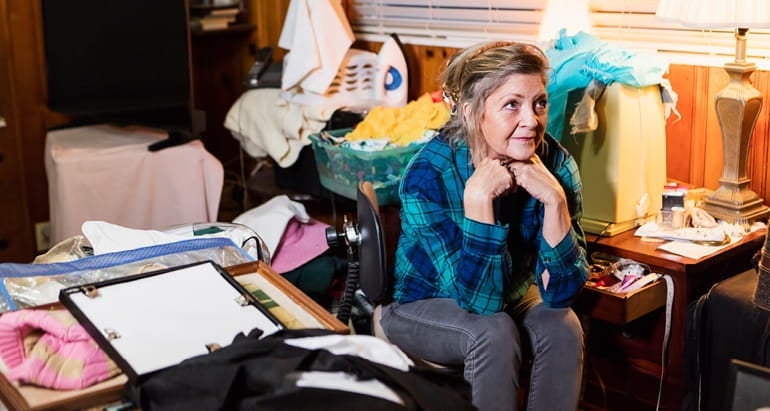If you’ve ever watched a show about hoarding, it can seem like an unbelievable situation. But for those who live with a loved one struggling with this condition, it’s all too real. Hoarding disorder can deeply impact a person’s life, relationships, and well-being. If someone close to you is dealing with hoarding, these tips, backed by the experience of those who’ve lived through it, can guide you through the process of offering support and understanding.
Related: How to Ease Your Aging Parent Into Accepting Help
What is Hoarding Disorder?
Hoarding disorder is often misunderstood and confused with collecting. While collecting involves a person deliberately gathering items and often parting with them over time, hoarding is rooted in the inability to discard items due to a perceived need to save them. This behavior can create significant emotional distress, and the resulting clutter often makes living spaces unusable.
Guaranteed Acceptance Life Insurance
Coverage options starting at $9.95 a month!
Guaranteed acceptance life insurance without medical exams, health questions, or rate increases.
According to the American Psychiatric Association (APA), hoarding disorder is characterized by:
- Persistent difficulty parting with possessions
- A need to save items
- Emotional distress when attempting to get rid of things
- Severe clutter that interferes with daily life
Hoarding affects about 2.6% of the global population, with higher rates among people over the age of 60 and those with additional mental health challenges like anxiety or depression. The behavior tends to develop early in life and becomes more intense over time.
Amy’s Story: A Family’s Struggle with Hoarding
Amy from Natick, Massachusetts,1 knows all too well the challenges of living with hoarding. She grew up with three family members who hoarded, her grandparents and aunt, who all lived under the same roof. Her grandfather, after a stroke, needed hospice care, but due to her grandmother’s refusal to make space, he was never allowed to return home. Her aunt, similarly, had to leave for health reasons.
Each family member hoarded different types of items, including food, clothes, books, toiletries, and even VHS tapes. Amy remembers, “There were parts of the house where you could only walk sideways, and some areas were completely inaccessible. The bathtub was full for over 10 years, and they had to wash up in the sink or at a gym.”
As severe as this situation was, Amy learned the importance of support. “I found it helpful to open up to my closest friends. When they offered to help, I accepted, as long as my grandmother was okay with it,” she says. “It was a challenge because hoarding is often misunderstood. People think it’s just a messy situation, but it’s much more than that.”
Over the years, Amy and her family dedicated thousands of hours to helping her grandmother and making the house safer. Despite the difficulties, Amy highlights the importance of keeping relationships intact. “When your loved one is ready to accept help, you’ll want to still have a relationship with them,” she stresses.
4 Steps to Support a Loved One Struggling with Hoarding
1. Examine Family Dynamics: Hoarding often affects the entire family. Many family members unknowingly enable the behavior, like paying for storage units or avoiding confrontations out of fear of upsetting the person struggling with hoarding. The International OCD Foundation suggests families ask themselves how they’re accommodating the hoarding. Start small by setting boundaries to stop enabling.
2. Educate Yourself: Amy credits much of her success in supporting her family members to the knowledge she gained about hoarding. “Learning from experts helped me better communicate with my family and avoid unnecessary confrontations,” she shares. Education reduces misunderstandings and opens the door to more effective conversations.
3. Address Safety Risks: Hoarding isn’t just an emotional or mental concern. It’s a physical safety issue. Hoarding can create significant hazards such as blocked exits, fire risks, and health issues from clutter or poor sanitation.
The Massachusetts Executive Office of Health and Human Services notes concerns like:
- Fire hazards from blocked exits or accumulated flammable materials
- Health risks from falls, respiratory issues, or infestation
- Difficulty for emergency personnel to access the home
- Risk to children, dependent adults and animals
If your loved one’s safety is at risk, it’s crucial to reach out for help. “Don’t feel guilty about calling for assistance when safety is compromised,” Amy advises. If needed, adult protective services can help address sanitation or safety concerns.
4. Seek Professional Help: There are several treatment options available for those with hoarding disorder. Cognitive Behavioral Therapy (CBT) is widely recognized as the most effective approach. CBT focuses on changing the thoughts and behaviors that drive hoarding. Another method, Motivational Interviewing, is designed to help individuals explore their uncertainties about change while guiding them toward taking small steps to improve their situation.
If your loved one is ready to begin treatment, it’s important to connect with professionals who specialize in hoarding disorder for the best outcome.
Related: The Loneliness Epidemic: How it Impacts Health, Weight and Early Death
You’re Not Alone
Having a loved one who hoards can feel isolating, but it’s important to remember that you are not alone. Hoarding is a condition that affects millions of people worldwide. It didn’t happen overnight, and it won’t be resolved quickly, but with patience, understanding, and the right support, change is possible.
The key is to take action, whether it’s seeking help for your loved one, educating yourself, or finding support from others who understand. Remember, progress is made one small step at a time.
Want more? Check out our blog, Decluttering for the New Year: Simplifying Your Home for a Fresh Start.
Colonial Penn is here for you!
Colonial Penn has specialized in making life insurance simple and accessible by offering it directly to consumers since 1957. Click here to learn more.
1Amy’s name has been changed to protect her identity.





